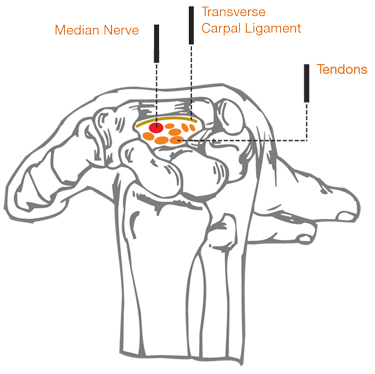Hand Procedures
MANOS CTR (CARPAL Tunnel release) Surgery
What is carpal tunnel release surgery?
Performed to treat carpal carpal tunnel syndrome (CTS), carpal tunnell surgery is one of the most common surgical procedures. During the procedure, the transverse carpal ligament is cut, which creates more space in the carpal tunnel and relieves pressure on the median nerve. Hence the reason the procedure is commonly called CTR, or carpal tunnel release.

There are two basic foms of CTR, open carpal tunnel release (OCTR), and endoscopic carpal tunnel release (ECTR). During an OCTR, the surgeon will make up to a two-inch incision in the wrist and palm to expose and cut the transverse carpal ligament. OCTR is performed under general anesthesia, and a tourniquet is used to limit blood flow to the hand. The goal of an ECTR is to reduce the incision size to allow for faster recovery and decrease scaring and pain after surgery. One or two half-inch incisions are made in the wrist and palm to allow a specialized camera called an endoscope to be placed within the carpal tunnel. A blade will then be inserted to cut the ligament. General anesthesia and a tourniquet are also used, and stitches are needed to close the incisions. Postoperative care is similar to OCTR, but varies based on the endoscopic system used.
The most advanced form of CTR is the innovative MANOS CTR™ procedure, the least invasive surgical option. Through a 2mm incision, the surgeon places the MANOS CTR system into the carpal tunnel under ultrasound and/or nerve stimulation guidance. The MANOS CTR system is then deployed and used to divide the transverse carpal ligament. Due to the small incision, general anesthesia, a tourniquet, and stitches are often not required.
- Quick procedure takes about 10 minutes
- Stitches not required
- No splinting
- Little to no scarring
- Fast recovery time
- No general anesthesia
The Coleman Cosmetic, Reconstructive and Hand Surgery Center is one of the first in the Los Angeles region to offer the MANOS CTR procedure.
Is it right for me?
The MANOS CTR procedure is suitable for most patients suffering from CTS. Because CTS is a progressive condition that can result in permanent damage to the median nerve, it should be diagnosed and treated as soon as possible. A detailed patient history including medical conditions, work history, and prior hand/wrist injuries is important. It will help determine if the patient's complaints are related to daily work or other activities or to an underlying physical disorder. X-rays may be used to rule out other causes, such as fractures or arthritis. A physical exam, including the Tinel test, Phalen exam, Webber test, or Van Frey test will likely be performed.
Electrodiagnostic studies are often performed to confirm the diagnosis and severity of CTS. The most common form is a nerve conduction velocity test. This measures the speed at which a nerve communicates. When impinged, as in CTS, nerves communicate at an impaired rate. Ultrasound imaging can reveal impaired movement of the median nerve. Magnetic resonance imaging (MRI), while promising, is not yet commonly used in diagnosing CTS.
Where is it performed?
The MANOS CTR procedure is performed on an out-patient basis at a nearby fully accredited outpatient surgery center.
Anesthesia and medication
Due to the small incision, general anesthesia or intravenous "twilight" anesthesia is typically sufficient. After the procedure, stitches are often not required. Typically two small band-aids are used to cover the surgical access points.
Recovery
Patients treated with MANOS CTR typically recover quickly, with most patients returning to work and moderate exercise in a few days. Postoperative care is limited and generally does not include splinting or physical therapy.
Trigger finger release (tfr)
What is TFR
Trigger finger is a painful condition that causes the fingers or thumb to catch or lock when flexed. With the thumb its called trigger thumb. Trigger finger occurs when tendons in the finger or thumb, which travel through narrow tendon sheaths, become inflamed or swollen. When this happens, bending the finger or thumb can pull the inflamed tendon through a narrowed tendon sheath, sometimes causing it to click or pop.
In many cases, the finger may be swollen and there may be a percepitable bump over the joint in the palm of the hand. The finger also may be locked in bent position, or it may be stiff and painful.
Treatment options:
- Depending on the severity of your condition,your physician may splint the hand to keep the joint from moving.
- If symptoms continue, your physcian may prescribe drugs that fight inflammation, such as ibuprofen or naproxen.
- Your physician may also recommend an injection of a steroid directly into the tendon sheath to temporarily reduce inflamation.
- If the condition still has not resolved itself, your physician may recommend TFR surgery.
Is it right for me?
If splinting, pharmaecuticals, or steriod injections are unsuccessful, FTR may be the best treatment option.
You must tell your doctor if you have any of these medical conditions:
- Cardiovascular disease
- High blood pressure
- Or other circulatory disorder or diabetes
Where is it performed?
FTR is performed on an out-patient basis at a nearby fully accredited outpatient surgery center.
Anesthesia and medication
This procedure is typically performed under local anesthesia with sedation.
Recovery
Most patients recover well enough to return to the work and most normal activities, including moderate exercise, in a few days.
Ulnar Nerve Release
The ulnar nerve runs around the back of the inner side of your elbow (your ‘funny bone’) and then through a narrow tunnel between the forearm muscles. Ulnar nerve compression, also called cubital tunnel syndrome, is a condition where increased pressure on the ulnar nerve can result in numbness in your ring and little fingers. Ulnar nerve release surgery is performed to release this pressure on the nerve.
Is it right for me?
Because this is a progressive condition that can result in permanent damage to the ulnar nerve, it should be diagnosed and treated as soon as possible.
Treatment options
If your symptoms are mild and occur mostly at night, your physician may recommend a splint to hold your elbow straight while you are in bed, often reducing the symptoms. However, in many cases it is best to have ulnar nerve release surgery to release the nerve to prevent permanent nerve damage.
Where is it performed?
FTR is performed on an out-patient basis at a nearby fully accredited outpatient surgery center.
Anesthesia and medication
This procedure is typically performed under local anesthesia with sedation.
Recovery
Most patients recover well enough to return to the work and most normal activities, including moderate exercise, in a few days.
Dupuytrens Contracture
What is Dupuytrens contracture surgery?
Dupuytren's contracture affects a layer of tissue that lies under the skin of your palm, resulting in a hand deformity. Knots of tissue form under the skin, eventually forming a thick cord that can pull one or more of your fingers into a bent position. It most commonly affects the ring finger and pinky.
Treatment involves removing or breaking apart the cords pulling your fingers in toward your palm. The choice of procedure depends on the severity of the symptoms.
Treatment options
The least invasive techique is needling, a technique using a needle inserted through your skin to puncture and "break" the cord of tissue that's contracting a finger. Another minimally invasive technique it to use enzyme injections into the taut cord in your palm to soften and weaken it. This allows your physician to later manipulate the hand with the aim of breaking the cord to straighten the fingers. If the condition persists, your phyiscian may recommend surgery to surgically remove the tissue in your palm affected by the disease. Diseased tissue may also attach to the skin, making it difficult to identify it and remove it completely.
The main advantage of surgery is that it results in a more complete joint release than that provided by the needle or enzyme methods. The main disadvantages are that physical therapy is usually needed after surgery, and the recovery time can be longer.
Where is it performed?
Dupuytren's contracture surgery is performed on an out-patient basis at a nearby fully accredited outpatient surgery center.
Anesthesia and medication
This procedure is typically performed under local anesthesia with sedation.
Recovery
Most patients recover well enough to return to the work and most normal activities, including moderate exercise, in 7-10 days, depending on the severity of your symptoms and any other health problems you may have. Physical therapy is usually needed after surgery, and the recovery time can be longer.








